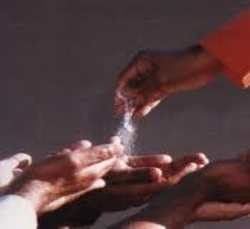The Answer Corner
Vol 4 Izdaja 2
March/April 2013
1. Question: How long can a remedy made in water be kept? Should we put it in the fridge? Can we
add vibhuti to the water?
Answer: The remedy should keep for up to 7 days when put in a capped bottle but it is not recommended to store it in the fridge. Adding vibhuti is unnecessary.
_____________________________________
2. Question: If it is difficult for a working person to take the afternoon dose, is it ok to take it twice a day in the morning and at night instead of the usual TDS?
Answer: Taking it twice a day is better than not taking. TDS will give the best results.
_____________________________________
3. Question: Can we take the remedy immediately after brushing our teeth; is brushing with toothpaste considered like taking food? Should we avoid using mint-flavour toothpaste because it could interfere with the vibration in the pills?
Answer: No, it is best to wait for at least 20 minutes after brushing. Mint doesn’t matter, all toothpastes have their own vibrations.
_____________________________________
4. Question: When I give the pills to my children, even though I wait for 20 minutes after they have eaten, there are still some food particles left in their mouth, is it OK to give the remedies?
Answer: It is best to rinse the mouth well or drink water so that no particles of food are left in the mouth. Better still to give the remedy at least 20 minutes before the meal.
_____________________________________
5. Question: Do we shake the vial 9 times after each drop when putting more than one combo in a bottle of pills?
Answer: After each drop of a combo, shake lightly. After the last drop, shake 9 times in a figure of flat 8. Some practitioners prefer to put all the drops in an empty vial, add the pills and then shake in the usual way.
_____________________________________
6. Multiple skin ointment questions.
a. Question: Although the patient rubs it on his skin, does he need to use a plastic spoon to take out ointment from the container so as not to contaminate the entire prepared ointment with vibrations of his fingers?
Answer: Yes, that’s best.
b. Question: Do we apply the ointment on the patient’s skin for the first time like we put the first pill in the patient’s mouth? What if the skin infection is contagious?
Answer: No, we don’t touch the patient. He applies it himself.
c. Question: Is the dosage TDS – same as for the pills? Should the patient rub the ointment in? Should he use a bandage or band-aid to cover the skin?
Answer: Yes, dosage is TDS. It depends on the skin condition whether to rub it in or not. In the case of an open wound, for example, apply the ointment and use bandage or band-aid as appropriate. In the case of better skin condition, it may be appropriate to rub it in. Sometimes, it is good enough just to make the vibration in water and dab it on the skin with a cotton swab.
d. Question: How do we mix the CC drops into a cream or jelly, do we heat up the jelly so that it turns into a liquid state and then put CC drops in it and then mix it with a plastic spoon?
Answer: No, heating is not needed. Simply put one drop and mix well with a wooden/plastic spatula. Then, add another drop and mix; you may need to repeat this procedure 3 or 4 times (if the jelly is thick) until you are sure that the CC drops have mixed well with the jelly or the cream.
e. Question: Is it advisable to make eye or ear drops and how to do the same?
Answer: It is a good idea to take a two-prong approach in the case of eye, ear or skin problems. To make eye drops, put 1 drop of the combo in 200 ml of rose/distilled water. Then dispense in a 20/30 ml dropper bottle.
Warning: If you put one drop directly in 20/30 ml of water, it could cause a sting in the eye! Also, we should not put a CC drop directly in a patient’s mouth. For ear drops, put one drop of the CC in 20/30 ml of extra-virgin olive oil and shake well.
